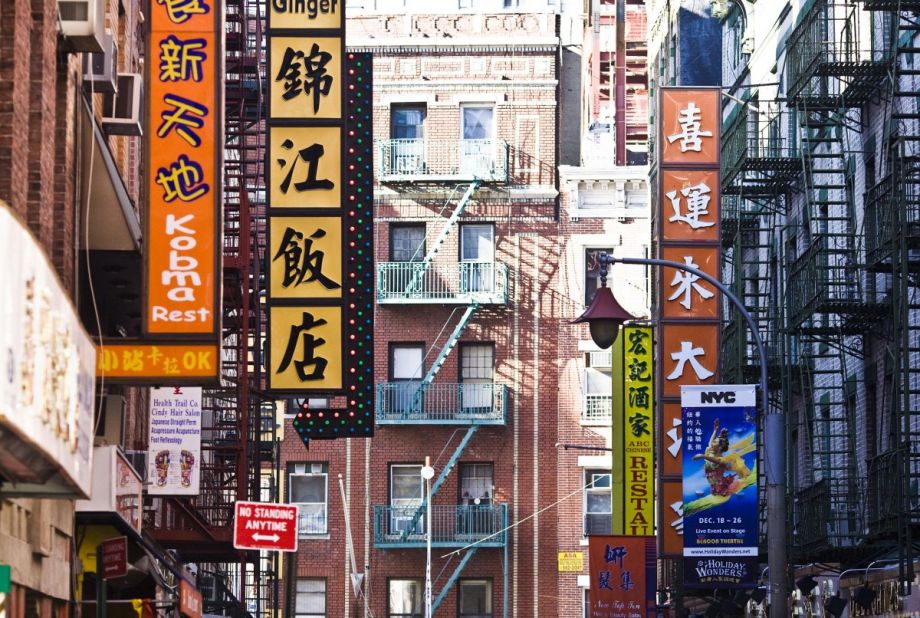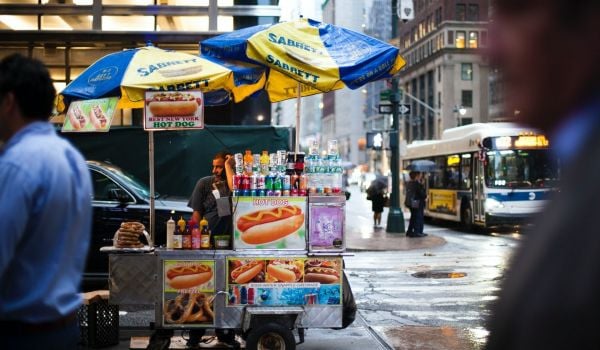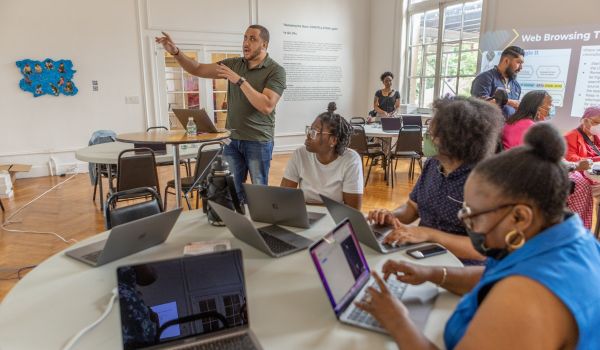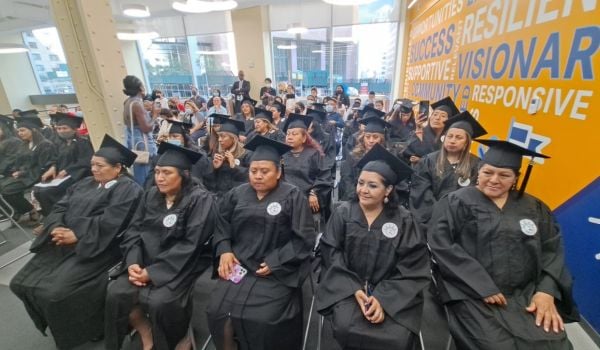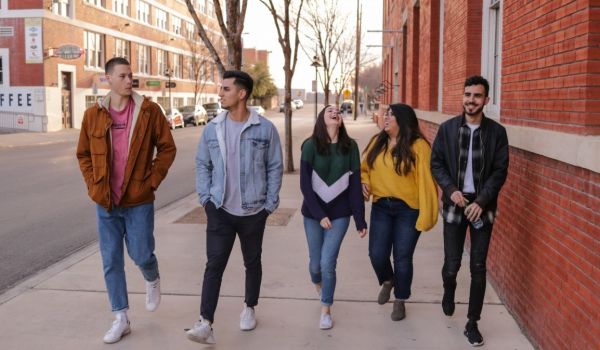It was a Saturday evening, and Yin Kong was putting on a show inside the mini greenhouse of a bamboo garden currently occupying a vacant lot near the east end of Canal Street in Manhattan’s Chinatown.
Kong was preparing tangyuan, little rice flour balls traditionally served in Chinese households on the last official evening of the annual Lunar New Year celebration, which occurs the same night as the first full moon of the year. As she prepared the rice flour dough, Kong asked the audience how they remember making tangyuan growing up. One person said they remember a filling, made from black sesame paste — common among families from Shanghai. Another remembered putting brown sugar inside, common in other parts of China. Someone else said you can also roll the little balls of the dough in crushed peanuts or sesame seeds before boiling them. Someone else said they preferred the savory over the sweet version of tangyuan.
Lacking a full kitchen, tonight it’s just a simplified version of tangyuan, Kong told the audience, who soon became a part of the makeshift kitchen crew. Everyone who wanted could take a turn to slap on a pair of gloves and roll a few balls of dough, to be boiled in a mixture of water and caramelized brown sugar — you boil them until they float, and there was more than enough for everyone.
“I’m okay with being unpolished and scrappy,” Kong tells Next City later. “I don’t need it to be perfect, the whole purpose is for people to get together and feel together.”
The evening was emblematic of the particular challenges and opportunities for community engagement and planning in Chinatowns across the U.S. In times of economic distress, like these past few weeks due to fears of the COVID-19 virus outbreak, it can feel more challenging than optimistic. Kong dove into the deep end of that challenge in 2017 when she co-founded Think!Chinatown, whose mission is “to attract and connect resources for Chinatown businesses and organizations using the tools of design & community engagement.”
Chinatowns tend to be multigenerational spaces, often with three or more generations occupying the same cramped residences, parks, libraries and sidewalks. They are linguistically diverse spaces — the most commonly spoken dialects are Mandarin or Cantonese, but there are many others, and it’s not uncommon for someone to speak multiple Chinese dialects but not English — or speak English with a thick New York accent. They’re ethnically diverse, too, with different waves of immigrant populations coming from different regions of China, each with its unique combination of dialect, cuisine and other customs. Some have lived in the U.S. for decades or generations; others are newer immigrants, but it’s not so obvious at first glance. And not everyone is Chinese, other East and Southeast Asian immigrant communities gravitate to Chinatowns as well.
Historically, racist policies and practices forced all those groups together into densely packed spaces that no one else wanted and most outsiders ignored. Partly as a result, in a city that’s 14 percent Asian, only one percent of city social service dollars go to organizations serving Asian communities.
“Chinatown was built off of exclusion,” Kong says. “Everyone has just been running on their own. There’s a bit of distrust, there’s not a practice of cooperating with the city or needing things from the city, so I think there needs to be an extra effort to build that connective tissue to ensure equity in resources coming to our neighborhood. You can complain all you want about the galleries coming in, but the first thing you can do is make sure the small businesses, the grassroots arts groups, are getting the same resources that all the other neighborhoods get. Start there.”
Kong, who grew up in suburban Maryland, first took on the challenge of community engagement in Asian neighborhoods in a place that seems either too obvious or completely unexpected — in China itself. After graduating from Columbia University with an urban studies degree, Kong found her way into an urban curator position in Beijing at Approach Architecture, under the tutelage of founder and chief architect Liang Jingyu.
“Think!Chinatown has a lot of parallels with Liang’s thinking about soft infrastructure rather than hard infrastructure, being collaborative, being a platform,” Kong says.
In her time at the firm, Kong worked on the Dashilar Project. Dashilar is a famous commercial district in central Beijing that still contains many buildings largely untouched since the days of the Ming Dynasty, which came to power in 1368.
“We had to figure out what to do with historic building stock, encouraging economic activation for the area without bulldozing it,” Kong says.
In China, Kong explains, there are thousands of years of historical precedent for bulldozing, with each new ruling dynasty wiping clean much of the built environment of the previous dynasty — if it had not been destroyed by warfare or natural disaster. The Cultural Revolution under Mao Tsedong was just one iteration of that pattern, Kong says.
“We always thought the [Dashilar project] would be a turning point for a new way to develop in China — more strategic, not wiping away everything, that bulldozer kind of mentality that was happening again leading up to the Olympics,” Kong says.
The Dashilar Project team created maps and programmed events to remind people of what was there and how it got there, in order to begin a healthy, productive conversation about how to build what was needed while saving what was worth saving. And there was plenty that needed building — Kong still remembers when she was working on the project, interviewing residents and merchants in the neighborhood and studying the built environment, anytime she needed to use a restroom with running water she had to leave the neighborhood.
The Dashilar project’s maps and community engagement programming were later exhibited at the 15th Venice Biennale, in 2016. Somehow through all that work she also picked up a side job teaching cooking classes at Black Sesame Kitchen in Beijing — gaining a skill set that would later come in handy.
Kong went back to Dashilar in 2015, a few years after her time on the project ended. She saw some changes that she had helped surface years before, and even used the bathroom at a restaurant in the neighborhood — with running water. The visit put her on the path to co-founding Think!Chinatown.
“The whole idea of the Dashilar Project was if you applied pressure to a few points, the whole acupuncture strategy, take a few key points and invest there and it will radiate outwards — seeing how there were changes done not just by the eventual project but by the neighbors seeing the changes, liking them and imitating them or adding to them. That was very encouraging,” Kong says. “It got me thinking again about being in that work.”
Kong eventually made her way back to NYC in 2016. She started reading books about contemporary Chinatown in Manhattan — New York City has anywhere from three to nine Chinatowns, depending on who you ask. She started attending every community planning meeting or arts and cultural event she could. She was looking for a place where she could plug in her unique skill set, including culinary arts education. But at the obvious places, she encountered cold shoulders, dead ends, or just no genuine demand for what she was offering.
Kong eventually crossed paths with Olympia Moy, an arts activist whose parents founded the Florentine School of Music, on Henry Street in Chinatown. Moy was in the midst of trying to expand the mission of the school into doubling as a community gathering space, and it was at the Florentine for a community visioning workshop about the school where Kong first met Moy. The two hit it off.
“We both use the same vocabulary and vision, we have a very similar approach to how change can be made,” Kong says.
It was another workshop, hosted by the W.O.W. Project, where Kong also hit it off with Amy Chin. The three started applying for grants from various city agencies.
One important early activity was to host a community engagement session in 2017 to gather input for the CreateNYC Cultural Plan for New York City. Advertised in local Chinese-language newspapers, the session brought out around 100 people, and there was spoken translation provided in the Mandarin, Cantonese, Toisan and Fuzhou dialects.
“A lot of the points that came up in our session were included in the final plan,” Kong says. “But from that we also learned from the groups that showed up there were so many gaps.”
They didn’t even have the name “Think!Chinatown” picked out yet, but the core of the group was already forming, in the volunteers who showed up to run that session. “People who were very well-educated, bi/tri-lingual, they showed up and were willing to help,” Kong says. “People who want to help but there’s not a channel for them to dive in and help.”
Kong says Think!Chinatown now has a spreadsheet of more than a hundred volunteers and counting, including what languages they speak, what skills they want to contribute, and what they like about Chinatown. Every time they have a free event — like the Lunar New Year gathering in the bamboo garden — Kong says they get a few more volunteers on the spreadsheet. One of the key ongoing activities has been matching bilingual volunteers with groups who need help applying for grants from otherwise willing funders like the Lower Manhattan Cultural Council.
Think!Chinatown’s biggest grant yet was to create HowToChinatown.nyc, a crowd-sourced website with profiles of Chinatown businesses, many of which don’t have their own websites. The profiles provide outsiders helpful guidance like how to order your first time at a restaurant, or what to order if you’re feeling more curious about all of what Chinatown has to offer. Retailers and arts groups also have profiles on the site. After building it in 2018, Kong and the team had a few thousand dollars left in the marketing budget, which they ended up using to fund their first annual Chinatown Arts Week — as a “series of marketing events” for HowToChinatown.nyc.
HowToChinatown.nyc and Chinatown Arts Week (the second annual was last fall) came as a response to one of the points that came up in that first community engagement session around the CreateNYC Cultural Plan — the need for more external visibility on Chinatown’s various and smaller businesses and arts organizations, including ethnically specific businesses or arts groups who have typically advertised only among their own circles.
Many Chinatown businesses have survived and in some cases thrived until recently, as the rising desirability of Chinatown has put new pressure on them to boost revenues in the face of rising rents — not to mention older generations of owners and customers starting to dwindle. Then came the COVID-19 outbreak and the overblown fears that appear to be taking a hit on foot traffic and shopping in Chinatown. So far, no confirmed cases have been found in New York City.
The COVID-19 stigma over the neighborhood arrived just as Think!Chinatown itself was gaining some new steam. Last year it held its first fundraiser banquet, and Kong is now thinking about the next one. It’s a bit of a struggle for Kong, and it brings her to the brink of tears as she tells me how it felt exclusionary to charge $250 a plate for a fundraiser dinner. It’s a necessary evil, at least for now, as Think!Chinatown continues to expand its work.
This year, Think!Chinatown wants to build a program around preparing Chinatown residents to participate in official community design and planning meetings in and around Chinatown hosted by the city or developers in conjunction with various plans and projects around the neighborhood. That includes the plan to expand an existing city jail in Chinatown as part of the larger process to close Rikers Island. Think!Chinatown hopes that here, it can complement other work being done by local groups like Neighbors United Below Canal, which is hoping to file a lawsuit intending to delay the start of the jail project until at least the next local election.
“We want to prep our neighbors, to do the homework for our neighbors so they have fewer steps to participate,” says Kong, who lives in a fifth floor walkup on Henry Street in Chinatown. “The work we get funding for are arts and culture [programs]. But civic engagement, when you start asking for funding to question the processes of decisions and layers of government that affect our neighborhoods, there’s not that many places to ask.”
This article is part of The Bottom Line, a series exploring scalable solutions for problems related to affordability, inclusive economic growth and access to capital. Click here to subscribe to our Bottom Line newsletter.

Oscar is Next City's senior economic justice correspondent. He previously served as Next City’s editor from 2018-2019, and was a Next City Equitable Cities Fellow from 2015-2016. Since 2011, Oscar has covered community development finance, community banking, impact investing, economic development, housing and more for media outlets such as Shelterforce, B Magazine, Impact Alpha and Fast Company.
Follow Oscar .(JavaScript must be enabled to view this email address)



